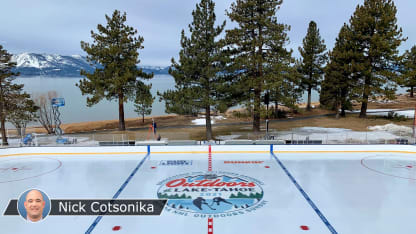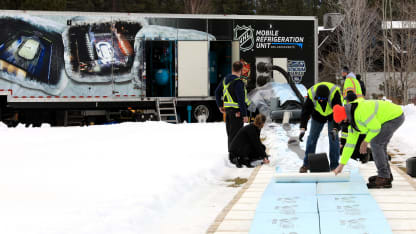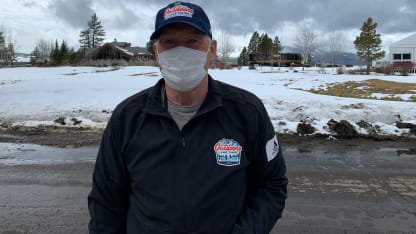STATELINE, Nev. -- Dan Craig looked at his pager one day in the late 1990s and saw the number for the NHL office in New York. As the League ice expert, he was in Washington for a game that night. Who needed him, he wondered, and what about?
NHL Lake Tahoe event owes nod to 'Mystery, Alaska'
League ice expert Craig assisted 1999 film, which helped spark outdoor hockey craze

When he phoned in to the office, Craig was told Howard Baldwin wanted to speak with him. Baldwin was a part-owner of the Pittsburgh Penguins at the time; he was also a movie producer. Craig called Baldwin in Los Angeles right away.
"Dan, do you know where Canmore, Alberta, is?" Baldwin asked.
"Yes."
"Do you know what a chinook is?"
"Yes."
"I have a movie set on top of a lake, and I'm losing an inch of ice a day. Anything that you can do to help me?"
The movie was "Mystery, Alaska," in which the New York Rangers travel to a fictional little town in the wilderness to play an outdoor exhibition.
Funny to look back on that now. The movie led to the idea of playing an outdoor hockey game in a stadium, which led to the NHL playing 30 outdoor games in stadiums since 2003, which led to the closest thing the NHL has ever done to "Mystery, Alaska," the NHL Outdoors at Lake Tahoe this weekend.
Life will imitate art when the Colorado Avalanche and Vegas Golden Knights play in the Bridgestone NHL Outdoors Saturday (3 p.m. ET; NBC, SN, SN1, TVAS) and the Boston Bruins and Philadelphia Flyers play in the Honda NHL Outdoors Sunday (2 p.m. ET; NBC, SN, SN1, TVAS).
You've got snowy mountains. You've got a TV crew broadcasting a unique spectacle. And behind the scenes, you've got a refrigeration trailer and pipes running to the ice so the show can go on.
Craig is now NHL vice president of facilities operations and is on site advising Derek King, who is NHL senior manager of facilities operations and in charge of the rink on the 18th fairway of the golf course at Edgewood Tahoe Resort.
Many details are different from how the ice was made in the movie, but not the basics.
"The trailer, the piping to the floor, is exactly the same as 'Mystery, Alaska,' " Craig said.
* * * * *
Craig grew up in Jasper, Alberta, 3½ hours northwest of Canmore, and knew all about chinooks, the warm, dry winds that blow down the east side of the Rocky Mountains in late winter. He had gone from working at his high school rink at age 15 to making ice for the Edmonton Oilers to joining the NHL in 1997.
His first project was building a rink atop a swimming pool at Yoyogi Arena in Tokyo so the Mighty Ducks of Anaheim and Vancouver Canucks could play two regular-season games to open the 1997-98 season. A few days beforehand, he called Brian Burke, then an NHL executive.
"Brian, don't put the boys on a plane. We can't do this. We just can't do this."
"Dan, you make it happen."
"OK."
The ice wasn't even close to what Craig considered the NHL standard, but he made it happen.

© Collin Kornfeind/Getty Images
So when he got off the phone with Baldwin, Craig called Ralph Goddard of Commercial Refrigeration, who had gone with him to Japan and built the refrigeration trailer they had used to make the ice there.
Craig knew the trailer had been in Edmonton to be serviced after the trip. Goddard told him it was on the way to Los Angeles.
"I need that trailer back in Alberta," Craig told him.
"Seriously?"
"Yes, seriously."
Craig never went to Canmore himself, but because he worked for the NHL and was asked to help the part-owner of an NHL team, he kept in constant communication with Goddard, who scrambled the trailer, equipment and manpower to the movie set.
"I know when Dan called Dad, we were stranded at a conference in Colorado Springs because they had a huge snowstorm," said Brad Goddard, son of Ralph Goddard, who died of cancer last year. "Dad took a rental car and drove anyway."
Ron Villetard was working for Commercial Refrigeration at the time and had just returned to Edmonton from installing an ice rink in New Hampshire. The office phoned.
"Don't unpack," he was told. "You've got to go to Canmore. They're doing a movie."
A movie?
"Boy, I tell you," Villetard said. "I jumped into the fire."
Villetard spent about a month in Canmore, alternating 12-hour shifts with a partner, working with the film's director, Jay Roach.
Long story short, they laid pipes so they could pump a brine solution through them, pull out heat with the refrigeration trailer and refreeze the surface. They even created a zigzag path of ice from a cabin downhill to the rink, so the Mystery team could leave its dressing room and make a grand entrance.
"It was interesting," Villetard said. "I could wander around the set. Some days, if they were going to shoot for an hour and they didn't need me, I'd go sit in the stands as a fan."
If you watch the movie closely, you can see the refrigeration trailer disguised as a TV truck. The steam rising from it gives it away.
* * * * *
After "Mystery, Alaska" was released on April 1, 1999, Michigan State University assistant hockey coach David McAuliffe got the idea of playing archrival Michigan at Spartan Stadium. The school decided to try it, scheduling an outdoor game for Oct. 6, 2001, and using the same refrigeration trailer used in the movie.
Again, warm weather caused problems with the ice. Craig made an emergency trip to East Lansing, Michigan, and was hands-on to the point of grabbing a mop bucket, making slush from snow and building a dam around the base of the rink himself, soaked to his knees.

Had it been a disaster, maybe outdoor hockey never would have gone any further. But with Craig's help and cooler weather by game time, Michigan State made it happen. The "Cold War" drew 75,544 fans, a world record for hockey at the time.
That gave the Oilers the idea of hosting an outdoor game, which the NHL turned into the Heritage Classic at Commonwealth Stadium in Edmonton on Nov. 22, 2003. A crowd of 57,167 braved bitter cold to see the Montreal Canadiens defeat the Oilers 4-3.
The first Winter Classic came Jan. 1, 2008, when Sidney Crosby scored the shootout winner in a snow flurry and the Pittsburgh Penguins defeated the Buffalo Sabres 2-1 before 71,217 fans at Ralph Wilson Stadium in Orchard Park, New York.
Outdoor hockey has been an NHL staple ever since. The League has hosted outdoor games across the continent in all kinds of conditions and in all kinds of stadiums before hundreds of thousands of fans. It has invested in its own infrastructure, including two refrigeration trailers. And it has gained the experience and confidence to tackle immense challenges.
When the coronavirus pandemic limited crowds, the NHL was forced to pivot this season. Playing outdoors in a remote setting without fans in attendance was always a romantic idea but never made economic sense. If ever there were a time to do it as a made-for-TV event, it is now.
So what if the NHL had never staged a game on a golf course? So what if the League had only one site visit and two months to plan?
Well, Tokyo was a long time ago, and none of this is a mystery anymore.
"If you ask the question, 'Can we do this?' Whatever [this] is, I'm always going to say yes," Craig said. "I know there's going to be challenges, but yes. Can we do it? Yes. Don't ever ask the question. 'Can you do it?' Yeah. We will make it happen."

















